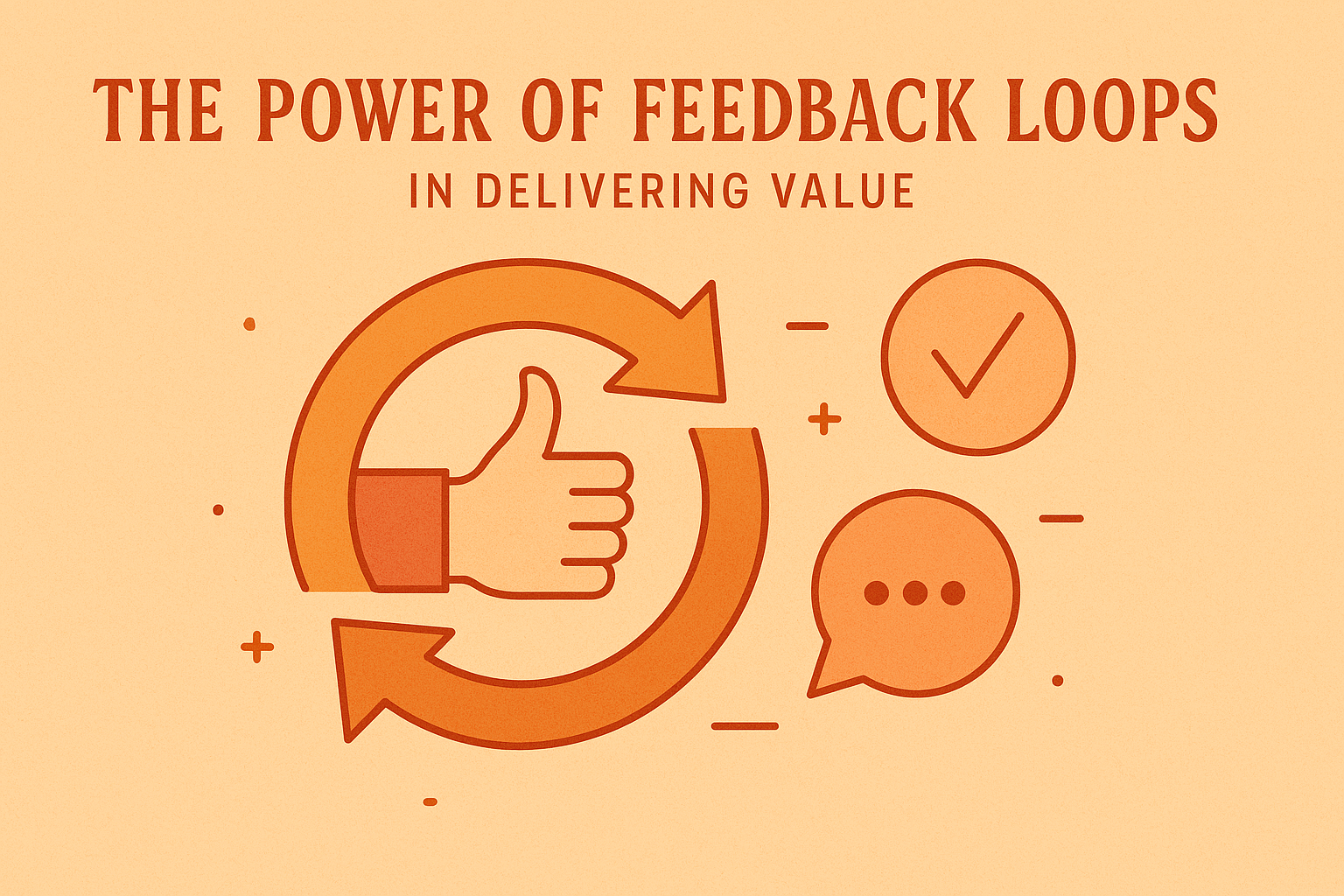The Power of Feedback Loops in Delivering Value

In the pursuit of delivering high-quality digital products, many teams focus on velocity, capacity, and output. But what truly drives sustainable value isn’t how fast we deliver - it’s how fast we learn.
That’s where feedback loops come in.
Feedback loops are the engine of continuous improvement in digital engineering. They help teams adjust, refine, and adapt - turning assumptions into insight, effort into impact, and delivery into value. Without them, teams are flying blind: delivering features without understanding their effect, fixing problems without knowing the root cause, and planning roadmaps based more on opinion than evidence.
If value is the destination, then feedback is the compass. And the shorter and tighter the loop, the faster you can course-correct, innovate, and improve.
What Are Feedback Loops?
A feedback loop is a cycle of action, observation, and learning. You make a change, observe the outcome, and use what you learn to decide what to do next.
In digital engineering, feedback loops exist at every level:
Code-level: Tests fail, linters alert, pull requests trigger review - prompting rework and learning.
Team-level: Retrospectives uncover what's working or not in how teams collaborate.
Product-level: Usage analytics and user feedback reveal which features deliver value and which fall flat.
Operational-level: Monitoring and incident data show how systems behave in production and where to invest next.
Each loop helps teams close the gap between intention and reality - and the faster those loops, the quicker we learn.
Why Feedback Loops Are Essential to Delivering Value
1. They Prevent Waste
Without feedback, teams may spend weeks or months building something users don’t need or want. Fast feedback tells you what’s working and what’s not - so you can stop investing in the wrong things and focus on what matters.
2. They Improve Quality and Resilience
Feedback loops catch issues early - whether in code, design, or delivery. Unit tests, integration checks, static analysis, and monitoring all feed real-time insights back to the team, helping prevent defects before they reach production.
3. They Drive Better Decisions
When feedback is available and accessible, decision-making improves. Teams move from intuition to evidence. Product managers prioritise based on real user behaviour, not assumptions. Engineers optimise based on system telemetry, not guesswork.
4. They Accelerate Learning and Innovation
Feedback loops encourage experimentation. A/B tests, feature flags, and iterative releases allow teams to test ideas, gather data, and pivot quickly - turning uncertainty into insight.
5. They Create Accountability and Ownership
When teams have visibility into outcomes, they take greater ownership of results. Feedback connects effort to impact - strengthening motivation, autonomy, and continuous improvement.
Building Effective Feedback Loops
Creating a feedback-rich environment isn’t accidental. It requires deliberate investment in both culture and capability. Here’s how to build tighter, more effective feedback loops:
✅ Make Feedback Immediate and Visible
The faster feedback reaches the people who can act on it, the more valuable it is. Use tools and practices that surface feedback in real time - whether it's code errors, deployment failures, or user analytics.
✅ Instrument for Observability
You can’t improve what you can’t see. Invest in logs, metrics, tracing, and user telemetry. Make system behaviour and user interaction visible to all roles - not just Ops or Product.
✅ Close the Loop, Don’t Just Capture It
Feedback isn’t valuable unless it leads to change. Ensure that insights from tests, users, and systems flow back into planning, design, and decision-making. Learn, don’t just measure.
✅ Automate Where It Makes Sense
Automated tests, alerts, and analytics pipelines speed up the loop and reduce human error. But combine automation with human judgement - some feedback (like user sentiment) needs context.
✅ Foster a Culture of Curiosity and Reflection
Make feedback safe, expected, and valued. Run blameless post-incident reviews. Encourage teams to ask, "What did we learn?" not just, "Did we deliver?" Curiosity is the heartbeat of a feedback culture.
Key Examples of Feedback Loops in Practice
CI/CD pipelines provide rapid code-level feedback so engineers can catch issues before deployment.
Feature toggles with analytics show which parts of a feature users engage with - and which they ignore.
Retrospectives give teams a structured loop to inspect and adapt how they work.
Customer feedback tools (like in-app surveys or NPS scores) surface sentiment in near real-time.
Observability platforms alert teams to anomalies, usage patterns, and production incidents - feeding back into system design and reliability practices.
Key Takeaways
✅ Feedback loops reduce risk and waste - by validating assumptions early and often.
✅ Shorter loops mean faster learning - accelerating innovation and continuous improvement.
✅ Feedback must lead to action - data without change is just noise.
✅ Observability, testing, and user insight are critical enablers of effective feedback.
✅ Culture matters - teams must feel safe to reflect, challenge, and adapt.
Final Thought
Feedback loops are not just engineering hygiene - they are the engine of value delivery. The faster we learn, the better we build. The better we build, the more value we create.
In a world where speed, complexity, and uncertainty are constant, the organisations that thrive are not the ones who build the most - they're the ones who learn the fastest.
And learning starts with listening - to our users, our systems, and each other. That's the power of feedback.
Engineering leader blending strategy, culture, and craft to build high-performing teams and future-ready platforms. I drive transformation through autonomy, continuous improvement, and data-driven excellence - creating environments where people thrive, innovation flourishes, and outcomes matter. Passionate about empowering others and reshaping engineering for impact at scale. Let’s build better, together.
